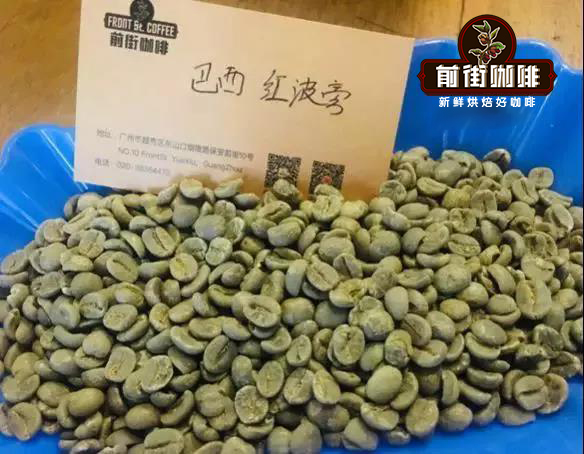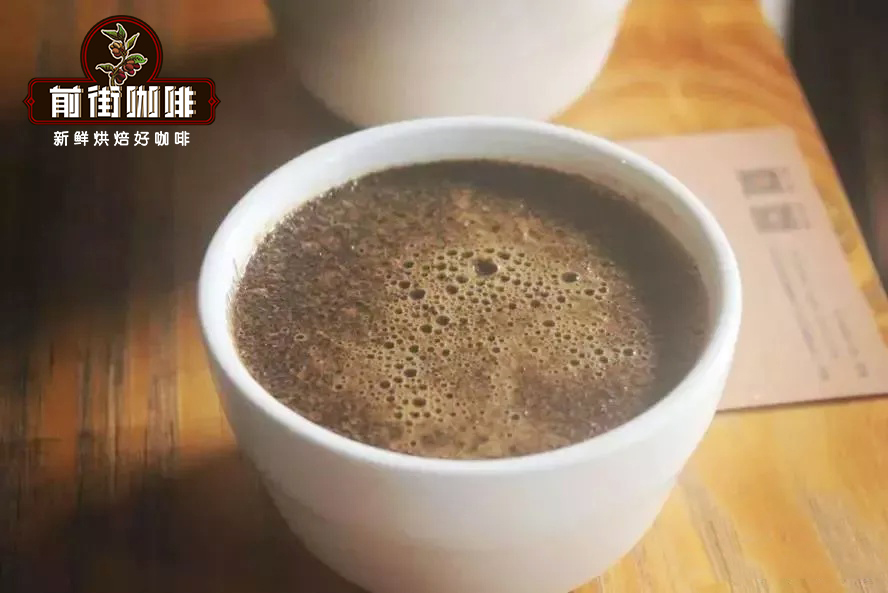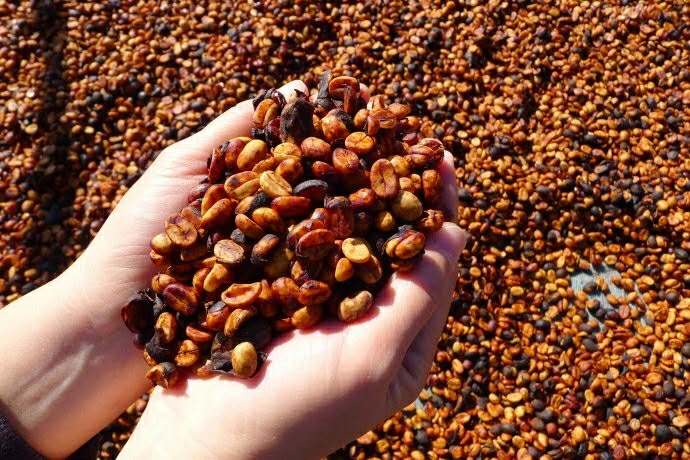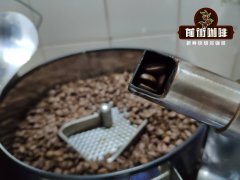Detailed process of coffee bean drying process the difference between sun-dried coffee and mechanically dried coffee

No matter how the coffee is processed, it needs to be dried. For washed coffee, the cherries are stripped and their mucus removed and dried. For coffee processed with honey, the drying process occurs when there is still some or all of the mucus on the parchment; because of its natural ingredients, the coffee will still be dried with its fruit and mucus.
There are two main ways to dry coffee. The first is to sprinkle beans on an elevated bed or terrace in the sun. The second is to use a special mechanical coffee dryer. Learn more about coffee drying and discuss these two methods.
Coffee drying
Rotary dryer in Lampung, Indonesia
Coffee drying: an overview
Coffee drying is a post-harvest process that usually preserves rather than improves the quality of coffee. Washed, natural and honey-processed coffee must be completely dried at certain stages of processing.
There are two main factors affecting coffee drying: temperature and air flow. Over time, they reduce the moisture in raw coffee.
Throughout the drying process, it is important to keep in mind the temperature limit of each treatment. Coffee in parchment should not be dried at a temperature higher than 40 °C, while natural coffee should not be dried at a temperature above 45 °C. Producers are also advised to keep the temperature constant during certain periods of the drying phase.
Water content should also be monitored to avoid mildew inside the beans. The moisture content before drying is between 40% and 50%, which should be reduced to between 11% and 12%.
When using a mechanical dryer, coffee is usually pre-dried to a certain extent in the sun. The dryer will then be used to complete the process with higher accuracy and accuracy.

Coffee drying is also one of the longest post-harvest processes, so this is the main bottleneck. The length of drying time depends on many factors, including weather conditions and processing methods.
If dried only in the sun, washed and half-washed coffee will take less time (six to nine days) to dry, while natural and honey processed coffee will take longer (10 to 14 days).
Although heat and airflow are the two main factors affecting the way coffee is dried, it is also important to focus on how water escapes from coffee beans. Bruno Ribeiro manages Pinhalense's North American, European and African markets. "if you dry in a moist environment where you can't give off moisture, then the coffee won't lose moisture," he said. "
Humidity is a very important issue when coffee beans are dried on a large scale in the sun. It delays the drying process and leads to inconsistent moisture content in a batch of raw coffee. However, in mechanical dryers (such as those sold by Pinhalense), the drum is perforated, resulting in the loss of moisture.
Iliana is the customer relationship manager of Azahar Coffee. She works closely with the Finca Isabelita team in Santa Mata, Sierra Nevada, Colombia. "generally speaking, when space and capacity permit, drying is usually limited to very small batches," she said. "
However, with newer, small batch rotary dryers and a range of drum sizes on the market, even miniature coffee production can benefit from mechanical dryers.
Coffee drying
Dryer with fruit shell feeder in Yunnan Province, China
Drying coffee in the sun: what are the risks?
The risks of drying coffee in the sun include uncontrolled fermentation, animal pollution, inappropriate manual drying and adverse weather conditions, all of which can have a significant impact on the quality of the cup.
When coffee is not sufficiently dry, uncontrollable fermentation may occur because microbes break down compounds in coffee and produce a bad taste. Animal pollution includes larger wild animals that cause physical damage to beans and animal droppings that fall in dry coffee (such as droppings from birds). Finally, when the coffee is not rotated correctly, incorrect manual drying occurs, resulting in uneven exposure to temperature and air flow.
Changing weather is another challenge for coffee producers that affect outdoor dry coffee, Bruno added. "after drying the coffee, it usually doesn't dry at night or early in the morning," he said. "
By using dry terraces, producers run the risk of exposing their coffee to roller coaster conditions. "
Ultimately, the sun depends on continuous heat and low humidity without adverse weather conditions or precipitation. During heavy rains, producers may face delays or risk coffee quality (which may cost them at least a year of hard work).
On the other hand, when the temperature rises, producers risk overheating and declining quality of the coffee, especially if it is not flipped very often.
Although overheating is a common risk associated with mechanical drying, many modern rotary dryers are equipped with internal thermometers or drying control systems that allow users to set maximum temperatures and avoid coffee overheating in coffee buckets.
"it can be difficult to dry if the producer is not in an area that [provides] flat space for coffee," Illiana said. " In addition to taking up more space, drying usually takes longer and is more likely to cause bottlenecks, she said.

"this may lead to delays in picking, cherries falling from trees or becoming overripe, and so on." As a result, mechanical dryers are useful for producers with limited space and can improve the overall productivity of the farm by saving more time.
Iliana added: "because of the historic use of mechanical clothes dryers in commercial coffee, they have been ignored and underestimated." But she says the advanced technologies available in modern mechanical dryers provide new advantages for specialty coffee producers.
Coffee cherries dry on an elevated bed
Mechanical dryer: an overview
The three main advantages of a mechanical dryer for drying coffee in the sun are the elimination of uncontrolled environmental variables that may affect coffee quality, improve accuracy and minimize delays.
In addition, since mechanical dryers protect coffee from a variety of weather, they can also help producers avoid anxiety about drying under adverse or unpredictable conditions.
One of the most important features of many modern rotary coffee dryers is the drying control system. These systems enable producers to control temperature through three independent variables: heat source, air and coffee.
In this way, the drying control system can provide more control for the manufacturer in the whole drying process. Some systems even allow producers to create "drying curves" to interrupt the dryer before reaching the maximum specified temperature.
"parameters such as time and temperature can be controlled by mechanical drying," Bruno said. He explained that this additional control means higher quality consistency and fundamentally reduces the risk of the drying process.
"in the long run, [mechanical dryers] will enable producers to maintain a consistent harvest after harvest. [as a result] they will continue to fight for loyal buyers who seek consistent quality coffee. "
Although mechanical dryers do require investment in equipment and fuel, these costs can be offset by labor time and money saved by manufacturers.
Bruno adds that such savings actually enable farmers to increase productivity and profit margins. "by reducing drying time and reducing manual rotation of coffee, producers will have more working time for harvesting and processing."
For coffee producers who can peel, mechanical dryers even provide farmers with new options for using crop by-products, he added. Both parchment and coffee peel can be used as fuel for dryers or as fertilizer because of their high potassium content.
Finally, Bruno told me that some Pinhalense rotary dryers are equipped with overhead silos. These can be used as pre-drying alternatives to minimize the risk of uncontrolled fermentation and optimize the use of excess energy, he said.
Two small batch dryers in El Salvador
Although drying coffee on elevated terrace beds is still an appropriate choice for many coffee producers, mechanical dryers have many different advantages. Technologies such as drying control systems provide manufacturers with higher accuracy and accuracy throughout the drying process.
Rotary dryers have historically been associated with drying large quantities of commercial or commercial grade coffee. Today, however, innovations in mechanical drying mean that they can also be applied to specialty production.
Important Notice :
前街咖啡 FrontStreet Coffee has moved to new addredd:
FrontStreet Coffee Address: 315,Donghua East Road,GuangZhou
Tel:020 38364473
- Prev

How long can coffee beans be drunk after roasting? How long is the bean-growing period of coffee?
Coffee can't be brewed immediately after baking. Where does this concept come from is very worthy of our exploration. What is the truth? Freshly roasted coffee beans contain slowly volatile carbon dioxide, and when coffee beans are ground into fine powder, the gas volatilizes faster and faster. The pressure released by gas volatilization prevents water from seeping into the coffee powder. The finer the coffee powder, the more water seeps.
- Next
Jamaica Blue Mountain Rose Summer Coffee beans the difference between Blue Mountain Rose Summer Coffee and Panama Rose Summer Coffee
Professional coffee knowledge exchange more coffee bean information please follow Coffee Workshop (Wechat official account cafe_style) 2020 can be said to be the most innovative year for Clifton Manor in the Blue Mountains of Jamaica. In the past, the varieties of iron cards were grown in the blue mountain producing areas, and the coffee beans were treated by washing, which made the blue mountain coffee notoriously clean, balanced and mellow. Open in 2019
Related
- Beginners will see the "Coffee pull flower" guide!
- What is the difference between ice blog purified milk and ordinary milk coffee?
- Why is the Philippines the largest producer of crops in Liberia?
- For coffee extraction, should the fine powder be retained?
- How does extracted espresso fill pressed powder? How much strength does it take to press the powder?
- How to make jasmine cold extract coffee? Is the jasmine + latte good?
- Will this little toy really make the coffee taste better? How does Lily Drip affect coffee extraction?
- Will the action of slapping the filter cup also affect coffee extraction?
- What's the difference between powder-to-water ratio and powder-to-liquid ratio?
- What is the Ethiopian local species? What does it have to do with Heirloom native species?

